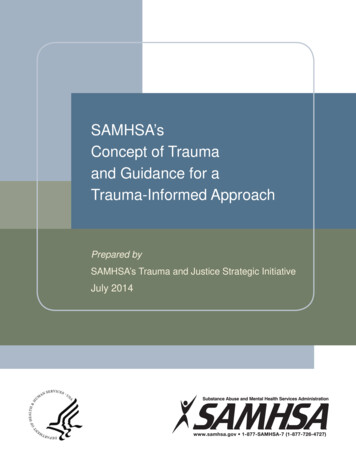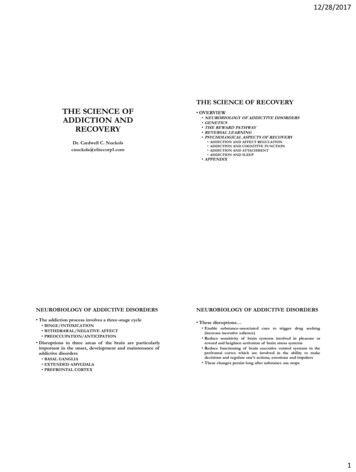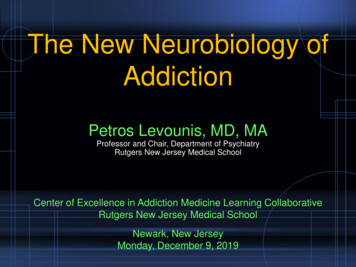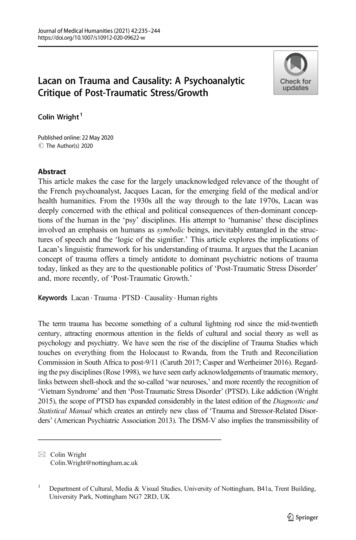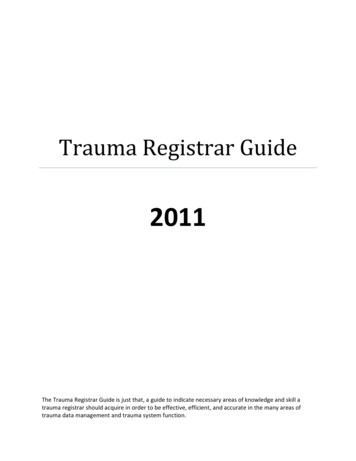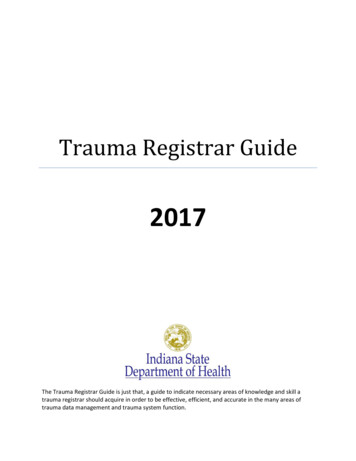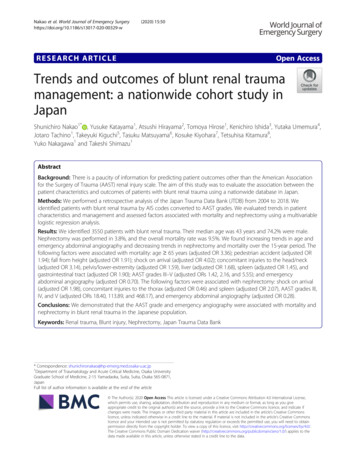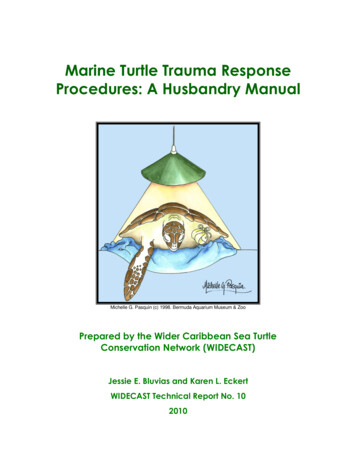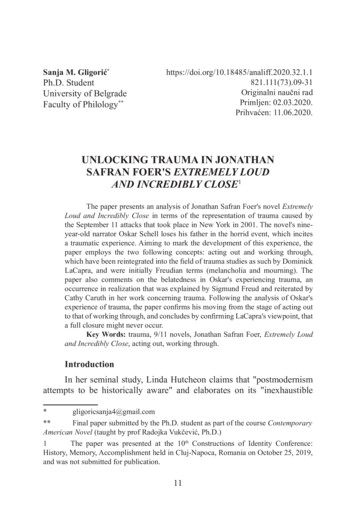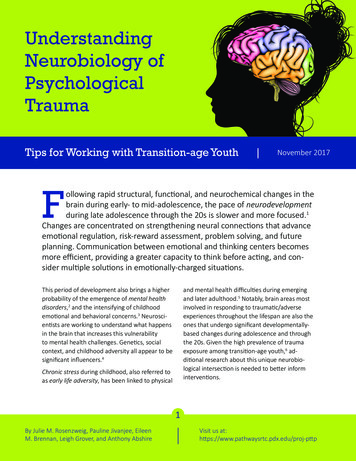
Transcription
UnderstandingNeurobiology ofPsychologicalTraumaTips for Working with Transition-age Youth November 2017Following rapid structural, functional, and neurochemical changes in thebrain during early- to mid-adolescence, the pace of neurodevelopmentduring late adolescence through the 20s is slower and more focused.1Changes are concentrated on strengthening neural connections that advanceemotional regulation, risk-reward assessment, problem solving, and futureplanning. Communication between emotional and thinking centers becomesmore efficient, providing a greater capacity to think before acting, and consider multiple solutions in emotionally-charged situations.This period of development also brings a higherprobability of the emergence of mental healthdisorders,2 and the intensifying of childhoodemotional and behavioral concerns.3 Neuroscientists are working to understand what happensin the brain that increases this vulnerabilityto mental health challenges. Genetics, socialcontext, and childhood adversity all appear to besignificant influencers.4and mental health difficulties during emergingand later adulthood.5 Notably, brain areas mostinvolved in responding to traumatic/adverseexperiences throughout the lifespan are also theones that undergo significant developmentallybased changes during adolescence and throughthe 20s. Given the high prevalence of traumaexposure among transition-age youth,6 additional research about this unique neurobiological intersection is needed to better informinterventions.Chronic stress during childhood, also referred toas early life adversity, has been linked to physical1By Julie M. Rosenzweig, Pauline Jivanjee, EileenM. Brennan, Leigh Grover, and Anthony AbshireVisit us at:https://www.pathwaysrtc.pdx.edu/proj-pttp
Trauma’s Neurobiological SignatureThe word trauma is often used in conversation to describe a range of stressful everydayexperiences. Yet not all stress changes a person’sneurobiology or the ability to feel emotionallysafe. Psychological trauma, a form of chronictraumatic stress, is felt emotionally and physically, and affects brain circuitry, including altering the stress response system.awareness and operating even after the traumaexposure has ended. The brain stores traumamemories as part of a protection strategy. Whenmemories quickly (and sometimes frequently)intrude into the present as upsetting thoughts,emotions, sensory memories, bodily sensations,or flashbacks, the original sense of fear, as wellas the associated self-protective, survival strategies are activated. Adaptive behaviors such asaggression, spacing-out, avoidance, and distrustbecome automatic responses to the slightestcue of danger. For example, trauma survivors’sensitivity to loud noises, odors, physical proximity to others, and touch can instantaneouslyactivate adaptive reactions.What is experienced as traumatic psychologicallydiffers across individuals. Psychological traumaincludes the individual’s subjective perception ofwhat is traumatic. Key factors that influence thisvariation include prior trauma, developmentalstage, severity of the trauma exposure, and theinvolvement of interpersonal relationships. Forexample, adolescents are especially sensitive tosocial stressors from peer influences, comparedwith children and adults.7 Additionally, knowledge about historical trauma such as the effectsof African Americans’ experience of slavery andepigenetic transmission informs understandingof individuals’ vulnerability to psychologicaltrauma.8,9 Recognizing the neurobiologicalunderpinnings of psychological trauma isessential to service providers’ application oftrauma-informed care skills.Neuroplasticity is key to healing and recoveringfrom psychological trauma. The mind and bodycan learn to feel safe again. Updated adaptivestrategies develop when the threat is not imminent and safe relationships are available. Whenservice providers see traumatic stress responsesas neurobiologically-embedded coping adaptations rather than as symptoms of mental healthdisorders, or intentional disruptive behaviors,they can help individuals to revise these copingstrategies to better meet their current needs.Neuroplasticity & Adaptive CopingStrategiesThreat AssessmentSystem for SurvivalNeuroplasticity refers to the brain’s remarkableadaptableness. Adaptive survival-based copingstrategies that emerge in response to adversityare rooted in the biological imperative to survivelife-threatening situations and cope with theaftermath of trauma. Often formed during childhood, these adaptations are embedded in neuralnetworks, functioning outside of consciousThe stress-response system called the hypothalamus-pituitary-adrenal (HPA) axis is initiatedby actual or perceived threat. The amygdala,as the first responder, receives informationfrom the thalamus, (gatekeeper of incomingsensory information) which is rapidly screenedfor danger, with the potential of activating thepituitary (gland that releases hormones). The2
Figure 1. The Brain(Illustration by Halorie Walker-Sloss)hippocampal memory system assists in thisassessment by providing the amygdala withinformation from its database of past threats. Intandem with the prefrontal cortex (PFC), (criticalfor emotional regulation and decision-making),the hippocampi (memory storage structures) arealso essential in deactivating the HPA axis whenthreat subsides.stress hormone cortisol from the adrenal glands(producer of several key hormones). This overproduction creates a state of toxic stress withinthe body that changes the physical structure andfunction of the amygdalae, hippocampi and PFC.Although the brain’s intention is to promote ahigher possibility of survival through a state ofconstant vigilance, other capacities are compromised, such as thinking clearly and managingfeelings. The high levels of cortisol, and inabilityto emotionally regulate heighten the probabilityof the youth engaging in risky behaviors and ofthe onset of physical health issues.10Once the amygdala sounds the alarm, the HPAaxis releases a cascade of chemicals and hormones, mobilizing the individual to survive thethreat by fighting or fleeing. When mobilizing isnot possible, then survival through immobilizingkicks on, significantly slowing the individual’s lifesustaining systems (e.g. heart rate, breathing).These reactions are immediate, bypassing anythoughtful decision-making. Typically, when thereal or perceived danger passes, the HPA axisreturns to its pre-threat status.Youth who have experienced childhoodadversity, or have current toxic stress, are oftenstuck in fight or flight mode, feeling jumpy,anxious, or hyper-vigilant; some can be stuck inshutdown, feeling disconnected, foggy, numb,or unfocused. These feelings, the behaviors thatcoincide, and the reactions of others are confusing and disrupt functioning in daily activities andrelationships.However, when trauma is ongoing, such aschronic abuse or neglect in childhood, theHPA axis continues to flood the body with the3
Share about the brain’s natural abilities to adapt and promotesurvival during traumatic experiences.TIPS Support youth in sharing about their current coping behaviors, andassigning new meaning through a survival promotion lens. Help co-construct modifications in existing coping strategies andbrainstorm new strategies, especially ones that include healthyrelationships. Increase your awareness of the early signs of mobilizationresponses (fight & flight) and immobilization responses (shut-down)in youth. Observe and co-regulate. Talk with youth about the stress response system; guiding them innoticing emotional and physical sensations during activation. Learn to recognize implicit sensory activation cues that youth mayencounter (e.g. sounds/noises, smells/scents, touch/proximity, timeof day/year, celebrations). Minimize exposure when possible. Staycompassionate and curious when activation occurs.Co-regulation & Strengthening Resilience CapacityRelational Safety is KeyHow the caregiver attunes to and co-regulatesthe baby’s emotional and physiological statesteaches the infant how to trust and participatein relationships. Whether these early relationalexperiences are comforting or frightening tothe infant, a neurobiological imprint is made, aguidebook of sorts, for navigating relationships.People are neurobiologically hardwired to beemotionally connected with others. When thisbiological imperative to feel secure in earlyattachments is disrupted through traumaticexperiences, relationships are likely to generatea sense of fear, or anxiety, rather than a sense ofsafety and comfort. Youth receiving services haveoften experienced their earliest relationshipswith caregivers as unpredictable and unsafe.11Pre-verbal memories are stored and remembered quite differently compared withmemories from toddlerhood and beyond.Earliest memories are held in the amygdala’simplicit memory system and are “recorded”without narrative, or a sense of self, time, orplace. These memories are sensory-based, suchCommunication that facilitates the attachmentprocess during infancy is primarily throughnon-verbal, sensory-based signals, such assounds, touches, smells, tastes, and eye contact.4
as smells, temperatures, touches, tastes, andsounds, often associated with the caregivers. Atapproximately 2 years of age, the hippocampalexplicit memory system comes online and beginsrecording autobiographically. Recall of explicitmemories typically begins around the age of 5years and includes images and narratives with asense of self, time, and place.throughout the lifespan. Like early memories,trauma memories are recorded from a sensoryperspective. These memories can be hiddenfrom awareness, demonstrating the brain’s wayof protecting the individual from painful memories. However, fear can still be activated when asensory cue becomes present. Without explicitmemory access, we feel overwhelmed and reactwithout knowing why.It is the implicit memory system that is alsothe record keeper of psychological trauma Go slowly in your relational engagement. Remember this is not alinear process. Celebrate small achievements.TIPS Take a stance of “not knowing.” Youth are the experts on their lives.They have wisdom to share. Practice wondering and asking: “What’s happened to you?” ratherthan, “What’s wrong with you?” Listen more. Ask fewer questions. Co-regulate through empathy and attuning verbally and non-verbally. Limit “Why?” questions. Use open-ended questions that invite curiosity and self-reflection,rather than require answers. Notice when emotions quickly shift, which often indicates thatimplicit trauma memories have been activated. Stay in the present moment and respond with compassion andacceptance. Resist the urge to give interpretations; instead offer insights, andfacilitate exploration of possible outcomes in specific situations. When you make a mistake—acknowledge, apologize, and rewind,modeling expression of vulnerability, courage, and honesty.5
Vicarious Traumatization & Wellness PracticesProviding services to youth affected by psychological trauma is rewarding and challenging.While bearing witness to a youth’s suffering iscentral to this work, there is a personal cost tocaring that is unavoidable. This cost has differentnames: compassion fatigue, vicarious traumatization, and secondary traumatic stress.12 Like directexposure to trauma, providers’ indirect exposureto trauma impacts their neurobiology, with theeffects emerging cumulatively over time.Examples of possible effects of vicarioustraumatization: Physical: Fatigue, physical symptoms (e.g.headaches), frequent illness Emotional: Irritability, resentment, hopelessness, feeling unsafe Cognitive: Intrusive thoughts, images, doubting competency Behavioral: Avoidance, unhealthy coping,isolatingAs a service provider, your greatest resourceis your ability to engage youth in a connected,trustworthy relationship. Your self-awareness,authenticity, and a well-regulated neurobiologyare foundational to the youth’s experienceof relational trust and a felt sense of safety.Recognizing the indicators of vicarious traumaand staying healthy are essential to beingtrauma-informed. Relational: Emotional spill-over, being argumentative, joyless, distracted.Use these examples to regularly conduct aself-inventory. Develop a rating scale and trackchanges in effects. Write down personal andprofessional wellness and self-care strategies.TIPS As you witness suffering and realize its effects on you, also recognize the positive effects of witnessing resilience. Share your experience of vicarious trauma with colleagues. Breakthe silence and aloneness that often accompanies experiences oftrauma work. Keep your list of wellness and self-care practices visible at yourworkplace and home. Practice at least 1 or 2 daily. If you supervise peer support providers, encourage them toproactively make self-care plans.6
References1.Baker, S. T., Lubman, D. I., Yücel, M., Allen, N.B., Whittle, S., Fulcher, B. D., . & Fornito, A.(2015). Developmental changes in brain networkhub connectivity in late adolescence. Journal ofNeuroscience, 35(24), 9078-9087.2.Lee, F. S., Heimer, H., Giedd, J. N., Lein, E. S., Šestan,N., Weinberger, D. R., & Casey, B. J. (2014). Adolescent mental health—opportunity and obligation.Science, 346(6209), 547-549.3.Keshavan, M. S., Giedd, J., Lau, J. Y., Lewis, D. A.,& Paus, T. (2014). Changes in the adolescent brainand the pathophysiology of psychotic disorders.The Lancet Psychiatry, 1(7), 549-558.4.Aas, M., Henry, C., Andreassen, O. A., Bellivier, F.,Melle, I., & Etain, B. (2016). The role of childhoodtrauma in bipolar disorders. International Journal ofBipolar Disorders, 4(1), 2-21.5.Nusslock, R., & Miller, G. E. (2016). Early-lifeadversity and physical and emotional health acrossthe lifespan: A neuroimmune network hypothesis.Biological Psychiatry, 80(1), 23-32.6.7.development. Trends in Cognitive Sciences, 19(10),558-566.8.Kirmayer, L., Gone, J., & Moses, J. (2014). Rethinking historical trauma. Transcultural Psychiatry,51(3), 299-319.9.Walters, K. L., Mohammed, S.A., Evans-Campbell,T., Beltrán, R. E., Chae, D. H., & Duran, B. (2011).Bodies don’t just tell stories, they tell histories:Embodiment of historical trauma among AmericanIndians and Alaska Natives. Dubois Review, 8(1),179-189.10. Layne, C. M., Greeson, J. K., Ostrowski, S. A., Kim,S., Reading, S., Vivrette, R. L., . & Pynoos, R. S.(2014). Cumulative trauma exposure and highrisk behavior in adolescence: Findings from theNational Child Traumatic Stress Network coredata set. Psychological Trauma: Theory, Research,Practice, and Policy, 6(S1), S40-S49.11. Heim, C., Shugart, M., Craighead, W. E., & Nemeroff, C. B. (2010). Neurobiological and psychiatricconsequences of child abuse and neglect. Developmental Psychobiology, 52, 671-690.Frounfelker, R., Klodnick, V. V., Mueser, K. T., &Todd, S. (2013). Trauma and posttraumatic stressdisorder among transition‐age youth with seriousmental health conditions. Journal of TraumaticStress, 26(3), 409-412.12. van Dernoot Lipsky, L. (2009). Trauma stewardship:An everyday guide to caring for self while caringfor others. San Francisco, CA: Berrett-KoehlerPublishers.Fuhrmann, D., Knoll, L. J., & Blakemore, S. J.(2015). Adolescence as a sensitive period of brain7
RESOURCES Masselli, B., & Bergan, J. (n.d.). A guide for youth: Understandingtrauma. Youth MOVE National, and National Technical AssistanceCenter for Children’s Mental Health, Georgetown UniversityCenter for Child and Human Development. Available at: edCare/UnderstandingTrauma V3.6.pdf The JPB Research Network on Toxic Stress. (2017). Website maintained by the Center on the Developing Child, Harvard University.Available at: b-research-network-on-toxic-stressSuggested CitationRosenzweig, J. M., Jivanjee, P., Brennan, E. M., Grover, L., & Abshire, A. (2017). Understanding neurobiology of psychological trauma: Tips for working with transition-age youth. Portland, OR: Researchand Training Center for Pathways to Positive Futures, Portland State University.PATHWAY STipsheet produced by Pathways Transition Training Partnership, Research andTraining Center for Pathways to Positive Futures, Portland State University,Portland, OR.www.pathwaysrtc.pdx.eduThe contents of this tipsheet were developed under a grant with funding from the National Instituteof Disability, Independent Living, and Rehabilitation Research, and from the Center for Mental HealthServices Substance Abuse and Mental Health Services Administration, United States Department ofHealth and Human Services (NIDILRR grant 90RT5030). NIDILRR is a Center within the Administrationfor Community Living (ACL), Department of Health and Human Services (HHS). The contents of thistipsheet do not necessarily represent the policy of NIDILRR, ACL, HHS, and you should not assumeendorsement by the Federal Government.8
the body that changes the physical structure and function of the amygdalae, hippocampi and PFC. Although the brain’s intention is to promote a higher possibility of survival through a state of constant vigilance, other capacities are compro-mised, such as thinking clearly and mana
